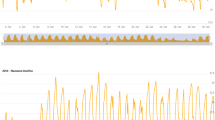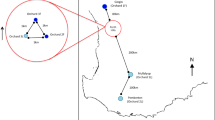Abstract
In Northern Germany, a major share of postharvest losses of apple fruit is due to preharvest infections by pathogenic fungi. Little is known about their infection biology. Inoculation experiments were conducted with the most important storage-rot pathogen Neofabraea perennans, as well as with the recently discovered minor rot Phacidiopycnis washingtonensis, by spraying developing fruit on apple trees with conidial suspensions to drip wetness between June and harvest time (September / October). All inoculation events in three trial seasons were chosen to coincide with natural rainfall. Phenological stages and meteorological parameters of each infection event were used for correlation analyses. Both pathogens produced increasing fruit rot levels with inoculation dates closer to harvest. In addition, for N. perennans seven environmental factors were positively correlated with disease incidence, the most significant ones being the duration of post-infection leaf wetness and the scab infection quotient incorporating wetness and temperature. With P. washingtonensis, in addition to fruit maturity three environmental factors were identified. In a second step, multifactorial models for both pathogens were created using the phenological and meteorological factors. For N. perennans, scab infection quotient until first drying-off, dry hours within the leaf wetness period and post-inoculation precipitation levels were identified as important factors, whereas for P. washingtonensis only the average temperature during the leaf wetness period had a significant influence on the rot incidence. Either model was extended by the viability of conidia used for inoculation. Possibilities to deploy these models for a more accurate a priori prediction of the likely severity of storage rot and a more targeted use of pre- and postharvest fungicides and physical postharvest treatments are discussed.




Similar content being viewed by others
References
Aguilar, C. G., Mazzola, M., & Xiao, C.-L. (2017). Timing of apple fruit infection by Neofabraea perennans and Neofabraea kienholzii in relation to bull’s-eye rot development in stored apple fruit. Plant Disease, 101(5), 800–806. https://doi.org/10.1094/PDIS-11-16-1637-RE
Aguilar, C. G., Mazzola, M., & Xiao, C.-L. (2018). Control of bull’s-eye rot of apple caused by Neofabraea perennans and Neofabraea kienholzii using pre- and postharvest fungicides. Plant Disease, 102(5), 905–910. https://doi.org/10.1094/PDIS-09-17-1363-RE
Aguilar, C. G., Mazzola, M., & Xiao, C.-L. (2019). Timing of perennial canker development in apple trees caused by Neofabraea perennans and Neofabraea kienholzii. Plant Disease, 103(3), 555–562. https://doi.org/10.1094/PDIS-06-18-0935-RE
Ali, E. M., Pandit, L. K., Mulvaney, K. A., & Amiri, A. (2018). Sensitivity of Phacidiopycnis spp. isolates from pome fruit to six pre- and postharvest fungicides. Plant Disease, 102(3), 533–539. https://doi.org/10.1094/PDIS-07-17-1014-RE
Beer, M., Brockamp, L., & Weber, R. W. S. (2015). Control of sooty blotch and black rot of apple through removal of fruit mummies. Folia Horticulturae, 27(1), 43–51. https://doi.org/10.1515/fhort-2015-0013
Blank, H. G. (1971). Fortschritte in der Bekämpfung des Gloeosporiumpilzes. Mitteilungen des Obstbauversuchsringes des Alten Landes, 26(6), 209–224.
Blumer, S. (1960). Obstbaumkrebs, Rindenbrand und Fruchtfäule. II. Durchführung und Ergebnisse der Infektionsversuche. Schweizerische Zeitschrift für Obst- und Weinbau, 69(25), 580–586.
Borecki, Z. (1961). Badania nad gorzką zgnilizną jabłek powodowaną przez grzyby Gloeosporium perennans Zeller et Childs, Gloeosporium album Osterw. i Gloeosporium fructigenum Berk. [Investigations on the bitter rot of apples caused by the fungi Gloeosporium perennans Zeller & Childs, G. album Osterw., and G. fructigenum Berk.]. Acta Agrobotanica, 10(1), 53–97. https://doi.org/10.5586/aa.1961.005
Børve, J., & Stensvand, A. (2017). Colletotrichum acutatum occurs asymptomatically on apple leaves. European Journal of Plant Pathology, 147(4), 943–948. https://doi.org/10.1007/s10658-016-1050-3
Børve, J., Røen, D., & Stensvand, A. (2013). Harvest time influences incidence of storage diseases and fruit quality in organically grown ‘Aroma’ apples. European Journal of Horticultural Science, 78(5), 232–238 https://www.pubhort.org/ejhs/2013/4044260.htm
Cameldi, I. (2015). Apple latent infection caused by Neofabraea alba: Host-pathogen interaction and disease management (Tesi di dottorato). University of Bologna, Bologna, Italy. Retrieved from http://amsdottorato.unibo.it/7162/
Cameldi, I., Neri, F., Menghini, M., Pirondi, A., Nanni, I. M., Collina, M., & Mari, M. (2017). Characterization of Neofabraea vagabunda isolates causing apple bull’s eye rot in Italy (Emilia-Romagna region). Plant Pathology, 66(9), 1432–1444. https://doi.org/10.1111/ppa.12684
Chen, C., Verkley, G. J. M., Sun, G., Groenewald, J. Z., & Crous, P. W. (2016). Redefining common endophytes and plant pathogens in Neofabraea, Pezicula, and related genera. Fungal Biology, 120(11), 1291–1322. https://doi.org/10.1016/j.funbio.2015.09.013
Den Breeyen, A., Rochefort, J., Russouw, A., Meitz-Hopkins, J., & Lennox, C. L. (2020). Preharvest detection and postharvest incidence of Phlyctema vagabunda on ‘Cripps Pink’ apples in South Africa. Plant Disease, 104(3), 841–846. https://doi.org/10.1094/PDIS-04-19-0818-RE
Díaz, G. A., Latorre, B. A., Ferrada, E., & Lolas, M. (2019). Identification and characterization of Diplodia mutila, D. seriata, Phacidiopycnis washingtonensis and Phacidium lacerum obtained from apple (Malus x domestica) fruit rot in Maule Region, Chile. European Journal of Plant Pathology, 153(4), 1259–1273. https://doi.org/10.1007/s10658-018-01640-8
Edney, K. L. (1956). The rotting of apples by Gloeosporium perennans Zeller & Childs. Annals of Applied Biology, 44(1), 113–128. https://doi.org/10.1111/j.1744-7348.1956.tb06850.x
Edney, K. L. (1958). Observations on the infection of Cox’s Orange Pippin apples by Gloeosporium perennans Zeller & Childs. Annals of Applied Biology, 46(4), 622–629. https://doi.org/10.1111/j.1744-7348.1958.tb02245.x
Enicks, D. A., Bomberger, R. A., & Amiri, A. (2020). Development of a portable LAMP assay for detection of Neofabraea perennans in commercial apple fruit. Plant Disease, 104(9), 2346–2353. https://doi.org/10.1094/PDIS-09-19-2036-RE
Giraud, M., & Bompeix, G. (2012). Postharvest diseases of pome fruits in Europe: Perspectives for integrated control. IOBC-WPRS Bulletin, 84, 257–263.
Giraud, M., & Moronvalle, A. (2012). Maladies de conservation de la pomme: biologie et épidémiologie des gloeosporioses. Infos Ctifl, 285, 21–29.
Görgens, M. (2017). Baumobsterhebung 2017 - Ergebnisse für das Niederelbegebiet. Mitteilungen des Obstbauversuchsringes des Alten Landes, 72(11), 324–329.
Henriquez, J. L., Sugar, D., & Spotts, R. A. (2008). Effects of environmental factors and cultural practices on bull’s eye rot of pear. Plant Disease, 92(3), 421–424. https://doi.org/10.1094/PDIS-92-3-0421
Holthusen, H. H. F. (2014). Strategien zur Minimierung von Pflanzenschutzmittel-Rückständen im Kernobst. Mitteilungen des Obstbauversuchsringes des Alten Landes, 69(5), 121–130.
Kaspers, H. (1967). Über das Auftreten verschiedener Gloeosporium-Arten an einigen Standorten und Apfelsorten. Erwerbsobstbau, 9(7), 124–126.
Kennel, W. (1988). Massives Auftreten des Gloeosporium-Pilzes Pezicula malicorticis. Obst und Garten, 107(10), 489–491.
Kim, Y. K., & Xiao, C. L. (2006). A postharvest fruit rot in apple caused by Phacidiopycnis washingtonensis. Plant Disease, 90(11), 1376–1381. https://doi.org/10.1094/PD-90-1376
Kim, Y. K., Curry, E. A., & Xiao, C. L. (2014). Infection of apple fruit by Sphaeropsis pyriputrescens in the orchard in relation to Sphaeropsis rot in storage. European Journal of Plant Pathology, 140(1), 133–143. https://doi.org/10.1007/s10658-014-0449-y
Klopp, K. (2020). Arbeitstagebuch für das Obstjahr 2020. ESTEBURG - Obstbauzentrum Jork.
MacHardy, W. E. (1996). Apple scab: Biology, epidemiology, and management. APS Press.
Maxin, P., Weber, R. W. S., Pedersen, H. L., & Williams, M. (2012). Control of a wide range of storage rots in naturally infected apples by hot-water dipping and rinsing. Postharvest Biology and Technology, 70, 25–31. https://doi.org/10.1016/j.postharvbio.2012.04.001
Maxin, P., Williams, M., & Weber, R. W. S. (2014). Control of fungal storage rots of apples by hot-water treatments: A Northern European perspective. Erwerbs-Obstbau, 56(1), 25–34. https://doi.org/10.1007/s10341-014-0200-z
Meier, U. (Ed.). (2001). Growth stages of mono- and dicotyledonous plants, BBCH monograph (Second ed.). German Federal Biological Research Centre for Agriculture and Forestry.
Michalecka, M., Bryk, H., Poniatowska, A., & Puławska, J. (2016). Identification of Neofabraea species causing bull’s eye rot of apple in Poland and their direct detection in apple fruit using multiplex PCR. Plant Pathology, 65(4), 643–654. https://doi.org/10.1111/ppa.12449
Mills, W. D., & Laplante, A. A. (1954). Diseases and insects in the orchard. Cornell Extension Bulletin, 711(rev. 1954).
Olsson, K. (1965). A study of the biology of Gloeosporium album and G. perennans on apples. Statens Växtskyddsanstalt Meddelanden, 13(104), 189–259.
Palm, G., & Kruse, P. (2005). Maßnahmen zur Verminderung der Verluste durch Fruchtfäulnis beim Apfel. Mitteilungen des Obstbauversuchsringes des Alten Landes, 60(2), 46–52.
Palm, G., & Kruse, P. (2012a). Untersuchungen zur Verhinderung von Lagerfäulnis bei Äpfeln durch Nacherntebehandlungen. Mitteilungen des Obstbauversuchsringes des Alten Landes, 67(10), 342–347.
Palm, G., & Kruse, P. (2012b). Wie ist in der Zukunft Lagerfäulnis zu verhindern? Mitteilungen des Obstbauversuchsringes des Alten Landes, 67(9), 306–311.
Pešicová, K., Kolařík, M., Hortová, B., & Novotný, D. (2017). Diversity and identification of Neofabraea species causing bull’s eye rot in the Czech Republic. European Journal of Plant Pathology, 147(3), 683–693. https://doi.org/10.1007/s10658-016-1036-1
Prusky, D., & Lichter, A. (2007). Activation of quiescent infections by postharvest pathogens during transition from the biotrophic to the necrotrophic stage. FEMS Microbiology Letters, 268(1), 1–8. https://doi.org/10.1111/j.1574-6968.2006.00603.x
R Core Team. (2020). R: A language and environment for statistical computing. R Foundation for Statistical Computing https://www.R-project.org/
Rasmussen, P. M., & Jepsen, H. M. (1958). Forsog med bekaempelse af Gloeosporium på aebler. Tidsskrift for Planteavl, 62, 280–291.
RStudio Team. (2020). RStudio: Integrated development for R. RStudio, PBC http://www.rstudio.com/
Schulte, E. (1997). Infektion und Krankheitsverlauf der Bitterfäule des Apfels während der Fruchtentwicklung und Lagerung. Mitteilungen des Obstbauversuchsringes des Alten Landes, 52(6), 237–247.
Sharples, R. O. (1959). Further orchard sources of infection by Gloeosporium spp. Plant Pathology, 8(2), 71–72. https://doi.org/10.1111/j.1365-3059.1959.tb00878.x
Sikdar, P., Mazzola, M., & Xiao, C. L. (2014). Infection courts and timing of infection of apple fruit by Phacidiopycnis washingtonensis in the orchard in relation to speck rot during storage. Plant Disease, 98(11), 1467–1475. https://doi.org/10.1094/PDIS-01-14-0054-RE
Sikdar, P., Willett, M., & Mazzola, M. (2018). Pruning of manchurian crabapple for management of speck rot and Sphaeropsis rot in apple. HortScience, 53(3), 329–333. https://doi.org/10.21273/HORTSCI12672-17.
Spotts, R. A. (1985). Effect of preharvest pear fruit maturity on decay resistance. Plant Disease, 69(5), 388–390. https://doi.org/10.1094/PD-69-388
Tahir, I. I. (2019). What spoils Swedish apples during storage? Acta Horticulturae, 1256, 463–468. https://doi.org/10.17660/ActaHortic.2019.1256.66
Tahir, I. I., Johansson, E., & Olsson, M. E. (2009). Improvement of apple quality and storability by a combination of heat treatment and controlled atmosphere storage. HortScience, 44(6), 1648–1654. https://doi.org/10.21273/HORTSCI.44.6.1648
Talvia, P. (1960). Various species of Gloeosporium in stored apples in Finland. Agricultural and Food Science, 32(1), 239–246. https://doi.org/10.23986/afsci.71532
Weber, R. W. S. (2009). Lagerfäulen an Äpfeln: Aktuelles aus Europa. Mitteilungen des Obstbauversuchsringes des Alten Landes, 64(6), 227–231.
Weber, R. W. S. (2011). Phacidiopycnis washingtonensis, cause of a new storage rot of apples in northern Europe. Journal of Phytopathology, 159(10), 682–686. https://doi.org/10.1111/j.1439-0434.2011.01826.x
Weber, R. W. S., & Palm, G. (2010). Resistance of storage rot fungi Neofabraea perennans, N. alba, Glomerella acutata and Neonectria galligena against thiophanate-methyl in Northern German apple production. Journal of Plant Diseases and Protection, 117(4), 185–191. https://doi.org/10.1007/BF03356359
Wenneker, M., & Thomma, B. P. H. J. (2020). Latent postharvest pathogens of pome fruit and their management: From single measures to a systems intervention approach. European Journal of Plant Pathology, 156(3), 663–681. https://doi.org/10.1007/s10658-020-01935-9
Wenneker, M., Köhl, J., van Leeuwen, P., Pham, K., & van Schaik, A. (2016). Control of postharvest storage rots of apples and pears in the Netherlands. Acta Horticulturae, 1144, 189–194. https://doi.org/10.17660/ActaHortic.2016.1144.27
Xiao, C. L., Rogers, J. D., Kim, Y. K., & Liu, Q. (2005). Phacidiopycnis washingtonensis—A new species associated with pome fruits from Washington State. Mycologia, 97(2), 464–473. https://doi.org/10.3852/mycologia.97.2.464
Xu, X.-M., & Robinson, J. D. (2010). Effects of fruit maturity and wetness on the infection of apple fruit by Neonectria galligena. Plant Pathology, 59(3), 542–547. https://doi.org/10.1111/j.1365-3059.2009.02232.x
Acknowledgements
We are grateful to Stefanie Kutz and Katharina Reisch for technical assistance.
Funding
The authors declare that they did not receive any funding for this study.
Author information
Authors and Affiliations
Contributions
Both authors designed and conducted the experiments, contributed equally to the writing of the manuscript, and approved submission of the final manuscript; HH performed data evaluation.
Corresponding author
Ethics declarations
Conflict of interest
The authors have no conflicts of interest to declare that are relevant to the content of this article.
Data availability
Data are available from the first author upon reasonable request.
Code availability
Not applicable.
Ethics approval
This manuscript did not involve any human participants, and/ or animals.
Consent for publication
Both authors agree to publication.
Rights and permissions
About this article
Cite this article
Holthusen, H.H.F., Weber, R.W.S. Infection conditions for Neofabraea perennans and Phacidiopycnis washingtonensis on developing apple fruit in the orchard. Eur J Plant Pathol 161, 895–906 (2021). https://doi.org/10.1007/s10658-021-02373-x
Accepted:
Published:
Issue Date:
DOI: https://doi.org/10.1007/s10658-021-02373-x




